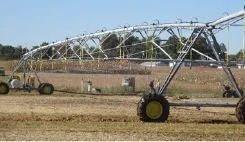The Kentucky Small Grain Growers selected research to fund earlier this year, bringing the total dedicated to wheat and small grain related research to $4 million in the past 30 years.
Read MoreThe University of Kentucky Wheat and Small Grains Variety Testing Program evaluates wheat and small grain (barley, cereal rye, oats, triticale, ancient grains) varieties that are commercially available or may soon be available to farmers. Annual variety performance testing provide farmers, seed producers, extension agents and consultants with current, unbiased information to help them select the varieties best adapted to their locality and individual requirements.
Read MoreIn an ongoing effort to bring production of rye grain back to Kentucky, Woodford Reserve today announced a five-year commitment to purchasing the grain from local farmers while working with the University of Kentucky to conduct research.
Read MoreCurrent projections predict a record U.S. corn and soybean crop during the 2023/24 marketing year. Although yield estimates can change drastically with growing season weather, the projections indicate a smaller gross revenue per acre in 2023/24 compared to 2022/23 due to lower price expectations. As winter wheat is approaching the end of the growing season, more information is known. Despite the drought in the west and lower yields, total production is still expected to be larger than last year due to increased wheat acreage. Wheat markets are still fluctuating due to geopolitical conflicts, but current projections indicate that the average gross revenue per acre of wheat will also decline compared to 2022/23.
Read Moreoday, Representatives Tracey Mann (R-KS-01), John Garamendi (D-CA-08), Rick Crawford (R-AR-01), and Jimmy Panetta (D-CA-19) introduced the American Farmers Feed the World Act of 2023. NAWG applauds this bipartisan effort to keep the food in America’s international food aid programs as Congress looks to reauthorize the Farm Bill in 2023. As part of this legislation, Congress would restore the original intent of the Food for Peace program without spending additional Farm Bill resources, all while safeguarding the interests of American farmers.
Read MoreRead the latest research report on managing Fusarium head blight (head scab) in wheat from the University of Kentucky. This research was conducted by Nathaniel White, Timothy Stombaugh, and Carl Bradley with funding from the Kentucky Small Grain Promotion Council. It was published in the Plant Health Progress research journal.
Read MoreA field study was grown in the harvest years 2021 and 2022 at Spindletop Farm (LEX) and the West Kentucky Research and Education Center (PRN). The overarching objective was to determine whether applications of sulfur fertilizer (S) in combination with various levels of N fertilizer would increase yield and N use efficiency.
Read MoreE-newsletter Volume 23, Issue 5, Department of Agricultural Economics, University of Kentucky.
Read MoreThe National Wheat Foundation is pleased to join the USDA Center for Nutrition Policy and Promotion as a MyPlate National Strategic Partner. The partnership presents a wealth of resources and collaborative opportunities aimed to enlighten individuals about the advantages of incorporating wheat into their dietary choices.
Read MoreWheat has not been known as a chief commodity in Kentucky due to higher production challenges when compared to corn and soybeans, but I’d encourage you to take another look.
Read MoreKentucky is known nationally for consistently growing a wheat/double-crop soybean rotation. This rotation has been a part of Kentucky agriculture for many years because of all its benefits.
Read MoreThe Kentucky Small Grain Growers and Walnut Grove Farms are proud to announce the 2023 recipients of the Don Halcomb Memorial Scholarships for Community Leadership Through Agriculture.
Read MoreWheat is big business in the Bluegrass state. According to the Kentucky Small Grain Growers’ Association, the state’s farmers harvested 30 million bushels of winter wheat from 375,000 acres in 2022. The University of Kentucky College of Agriculture, Food and Environment’s Grain and Forage Center of Excellence supports the state’s wheat growers in many ways, including an annual field day. The 2023 Wheat Field Day is May 9 at the UK Research and Education Center farm in Princeton.
Read MoreThe Kentucky Small Grain Growers Association is now accepting research proposals for the 2023-2024 growing season. Projects should be geared towards the research of small grain crops (wheat, barley, oats, rye, rice, and triticale).
Read MoreFor wheat fields that are Feekes 5 or less advanced, these temperatures should not harm the wheat. The growing point was still below the soil surface and well protected by the soil temperatures. This is evidenced by soil surface temperatures that we recorded at University of Kentucky’s Research and Education Center in Princeton.
Read MoreThe National Wheat Foundation and the National Association of Wheat Growers recently announced new officers of their organizations, electing Kentucky farmers to top leadership positions.
Read MoreAs the ‘meteorological’ winter ends (Dec 1 to Feb 28) for 2023, we are projected to have the warmest winter on record. This is impressive, considering the sub-zero temperatures in late December 2022. This has many people, including us, wondering: What does this mean for Kentucky’s 2023 winter wheat crop?
Read MoreWebster County grain farmers Bruce and Jeremy Benson have been named the 2023 University of Kentucky Wheat Science Group’s Service Award recipients.
Read MoreCongratulations to the 2022 Kentucky Wheat Yield Contest Winners. S & J Emmick of Hancock County harvested 132.68 bushels per acre. Camron Clay and Mark Wells from Union County are State Champions for the Tillage division at 121.91 bushels per acre.
Read MoreCorn harvest is now underway and Kentucky grain farmers will soon decide if and how much wheat they will plant this fall. Compared to last year there are significant increases in wheat and soybean prices, major increases in all fertilizer prices, and fuel prices that have almost doubled. The following analysis quantifies these relative changes to estimate the profitability for crops harvested in 2023. The analysis includes estimated returns comparing double-cropped wheat/soybeans with full-season soybeans for the 2023 crop, and the likely implications for Kentucky grain farmers.
Read More



















